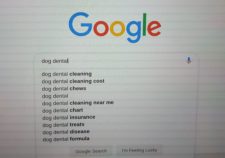Last month, we talked about some easy SEO tips you can use right away, to help improve your practice’s searchability online.
If you haven’t read it yet, I’d recommend starting there. Then, continue reading here for a super easy tip on how to find some great keywords and key phrases for your veterinary website.
This tool is free to use. And the best part is, there’s nothing new to learn! In fact, it’s something you probably already use every day…
I’m talking about Google’s Autocomplete function. This is where you start typing a word or phrase into Google, and it “fills in the blanks” for you.
You’ve probably noticed this before, but anytime you start typing something into Google, it offers a dropdown list of suggested ways to finish what you’re typing. In other words, it “autocompletes” the phrase for you.
You can try it for yourself. But, here’s a screenshot to show you exactly what I mean. Let’s try, “dog dental,” for example…
That list of phrases that drops down is very useful to you… because, those are all phrases that are very commonly searched in Google when it comes to “dog dentals.”
So, that’s free keyword information for you to use. And it only takes a couple of seconds to get a list of suggestions. No matter how busy you are, you have time to use Google Autocomplete!
As you can see, the top options here include: “dog dental cleaning,” “dog dental cleaning cost,” and “dog dental chews.” And further down the list are things like “dog dental insurance,” “dog dental chart,” and “dog dental disease.”
So, when you write a service page about dental cleanings, the above key phrases are very useful. Because the core information about dentals for dogs and cats will stay consistent… but, tweaking the words and details a little bit can help make it more likely that your practice’s website will show up higher in the search results.
Here’s an example of how to change the wording to your advantage, for SEO. Start with something you may have initially written for a page on your veterinary practice website, such as…
We offer dental procedures for pets. During the procedure, your pet will receive a thorough dental examination, a full scaling and polishing, and a full record of their oral health. And, you’ll receive instructions on how to care for their teeth at home. All procedures are performed under anesthesia, for the safety and comfort of your pet.
Now, compare this to the same wording, but optimized for SEO (plus minor changes to some sentences for clarity), using key phrases from Google’s Autocomplete function. Added keywords are highlighted in red…
We offer dental cleanings for dogs and cats. During the procedure, your pet will receive a thorough dental examination, and a full cleaning (including scaling and polishing). We’ll also create a dental chart (a record of the current health of their mouth and of each tooth, which will be helpful for monitoring any changes to their oral health). And, you’ll receive instructions on how to care for their teeth at home, including tips for brushing their teeth, and recommendations for dental diets and chews. All cleanings are performed under anesthesia, for the safety and comfort of your pet.
So, often you can use what you’ve originally written – with just a few, simple changes!
But here are a couple of tips to remember…
- Don’t overdo it and put so many keywords that it no longer reads clearly… If in doubt, read it out loud, and be sure it sounds natural when spoken, as if you were actually talking to a client.
- Notice that I didn’t try to fit ALL of the key phrases offered by Google. For example, I left out “dog dental cleaning cost,” because I didn’t think it would fit naturally here.
- And finally, notice that you don’t have to use the key phrases exactly as it was written. For example, “dental diets and chews” will work just as well as “dental chews.” That way, you’re free to fit the words in more naturally, in a way that works best for your website.
That’s really it! Use Google’s Autocomplete in conjunction with some other SEO tools — which I’ll tell you more about next month — and you’ll be well on your way to improved SEO. That means more clients finding you online… which helps more clients bring their pets in to see you!


